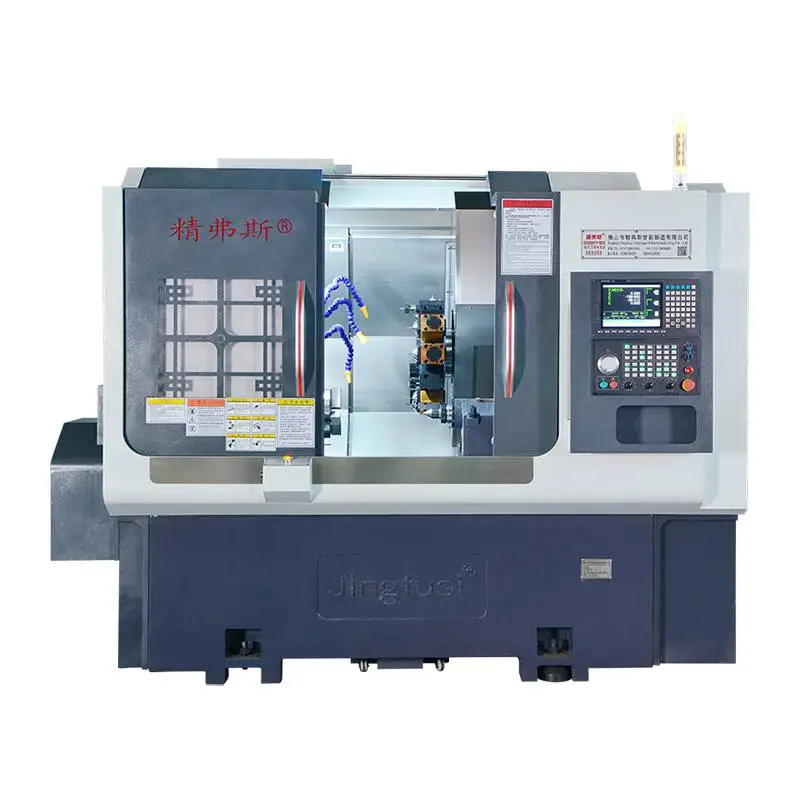A Comprehensive Guide to Turret Turning and Milling Machines
2024-10-23
In modern manufacturing, Turret Turning and Milling Machines play a critical role in producing high-precision components. These machines are designed to perform both turning and milling operations in one setup, making them highly versatile and efficient. For industries that demand complex parts with tight tolerances, these machines are essential tools.
In this blog, we will explore what turret turning and milling machines are, their key components, benefits, and how they are transforming manufacturing processes.
What is a Turret Turning and Milling Machine?
A turret turning and milling machine is a type of CNC (Computer Numerical Control) machine that integrates both turning and milling operations. The turret, which is a rotating tool holder, allows multiple tools to be mounted and used in sequence during a machining cycle. This multi-tasking capability reduces the need for multiple setups, saving time and increasing productivity.
The main function of the machine is:
- Turning: This process involves rotating the workpiece while a cutting tool removes material to create cylindrical shapes.
- Milling: In milling, a rotating cutting tool removes material to create features such as slots, holes, or flat surfaces.
By combining these two processes into a single machine, manufacturers can produce complex parts in one go, eliminating the need for separate machines for turning and milling operations.
Key Components of a Turret Turning and Milling Machine
To understand how these machines operate, it’s important to know the main components:
1. Turret Head: The turret is a rotating tool holder that can house multiple cutting tools. The turret rotates to position the appropriate tool during the machining cycle without requiring manual tool changes, improving efficiency.
2. Spindle: The spindle holds and rotates the workpiece for turning operations. It provides the necessary speed and torque to shape the material during turning processes.
3. Milling Head: The milling head contains the rotating cutting tool for milling operations. It can move in multiple axes to perform a variety of cuts, such as drilling, tapping, or contouring.
4. CNC Control Panel: The CNC system allows the operator to program and control both turning and milling operations. The software ensures precision and repeatability, making complex machining processes easier to execute.
5. Bed and Tailstock: The machine bed provides a stable base, and the tailstock supports longer workpieces during turning operations, preventing deflection and ensuring accuracy.
Benefits of Turret Turning and Milling Machines
Turret turning and milling machines offer several key benefits, making them highly valuable in the manufacturing industry.
1. Increased Efficiency
By combining turning and milling capabilities in a single setup, these machines significantly reduce the time spent on part handling, loading, and unloading. This leads to shorter cycle times and increased throughput, which is crucial for high-volume production environments.
2. Cost Savings
Since a turret turning and milling machine eliminates the need for multiple separate machines, it can save floor space and reduce capital expenditure. Additionally, fewer setups mean lower labor costs and less downtime.
3. Higher Precision
The CNC control ensures that parts are produced with high precision and repeatability. In industries such as aerospace, automotive, and medical devices, where tolerances are tight, this level of accuracy is vital.
4. Versatility
These machines can handle a wide range of materials, from metals like steel, aluminum, and brass to plastics and composites. Their ability to perform multiple machining operations in one setup also allows manufacturers to produce more complex geometries and intricate designs.
5. Reduced Lead Times
With faster production cycles and fewer machine setups, turret turning and milling machines help reduce lead times, which is critical for businesses that need to meet tight delivery schedules.
6. Improved Tool Management
The turret head allows for the use of multiple tools in sequence, streamlining tool management. This is especially beneficial when dealing with complex parts that require various cutting operations.

Applications of Turret Turning and Milling Machines
Due to their versatility, turret turning and milling machines are used in a variety of industries and applications:
- Automotive: These machines are used to produce engine components, shafts, and other precision parts.
- Aerospace: The aerospace industry relies on these machines for creating turbine blades, landing gear parts, and structural components.
- Medical Devices: High-precision components like surgical instruments, implants, and prosthetics are often made using these machines.
- Energy Sector: From producing components for wind turbines to parts for oil and gas exploration, these machines handle complex, durable parts with ease.
- General Engineering: These machines are ideal for manufacturing small to medium-sized batches of precision components for various engineering applications.
Types of Turret Turning and Milling Machines
There are several types of turret turning and milling machines available, each designed for different production needs:
1. Vertical Turret Lathe (VTL)
This machine has a vertical spindle orientation and is used for turning large, heavy workpieces, such as those found in the aerospace and energy sectors. The turret in this machine can perform milling, drilling, and tapping operations.
2. Horizontal Turning and Milling Centers
These machines feature a horizontal spindle, making them ideal for producing parts like shafts and rods. They combine turning and milling in one setup, allowing for efficient production of cylindrical and prismatic parts.
3. Multi-tasking CNC Machines
Multi-tasking CNC machines offer even more versatility, with capabilities such as 5-axis machining. They can produce highly complex parts with intricate features, making them ideal for industries like aerospace and automotive where precision and complexity are critical.
Choosing the Right Machine for Your Needs
When selecting a turret turning and milling machine, consider the following factors:
1. Part Complexity: For parts with intricate geometries, a multi-tasking machine with advanced CNC controls may be required.
2. Material: The type of material being machined will influence the choice of cutting tools and spindle power.
3. Production Volume: For high-volume production, look for machines that offer high-speed machining and tool change capabilities to minimize downtime.
4. Size of Workpiece: Larger workpieces may require a vertical turret lathe or a machine with a long bed and high spindle torque.
Conclusion
Turret turning and milling machines are revolutionizing modern manufacturing by offering unparalleled versatility, efficiency, and precision. Their ability to combine multiple machining processes in one setup makes them indispensable tools for industries that require complex, high-quality components. Whether you’re in aerospace, automotive, or medical manufacturing, these machines can help streamline production, reduce costs, and meet the demands of today's fast-paced markets.
As technology continues to advance, the capabilities of turret turning and milling machines are expected to grow, making them even more powerful assets for manufacturers around the world.


